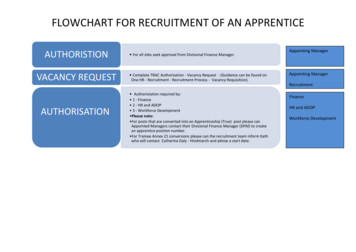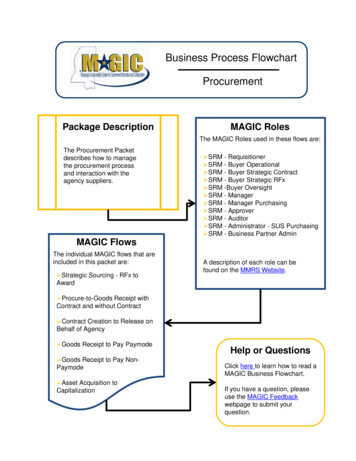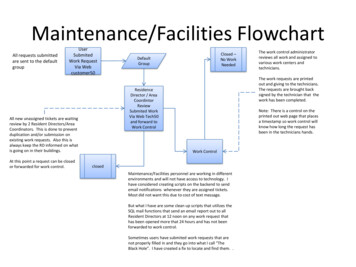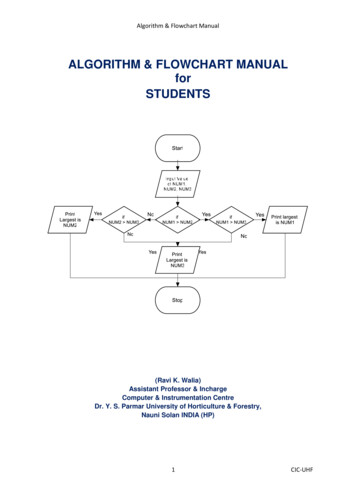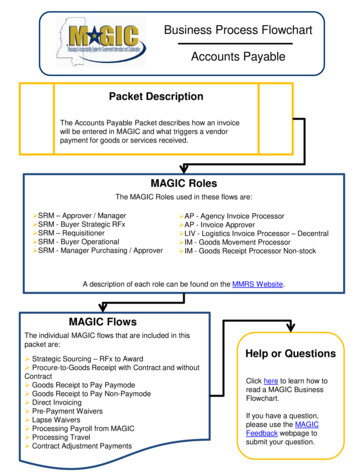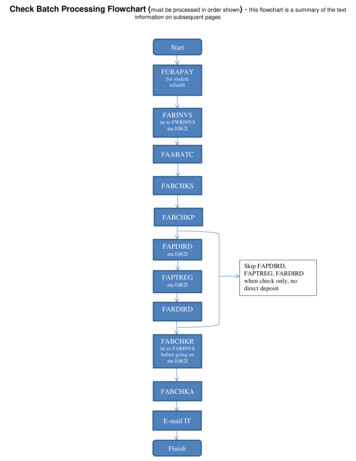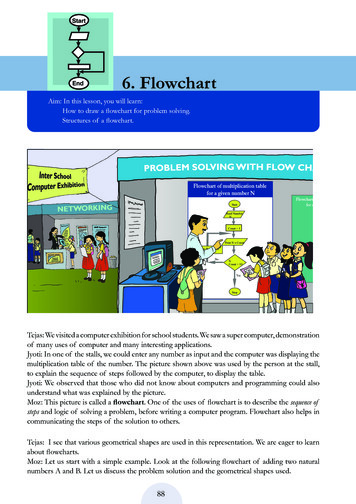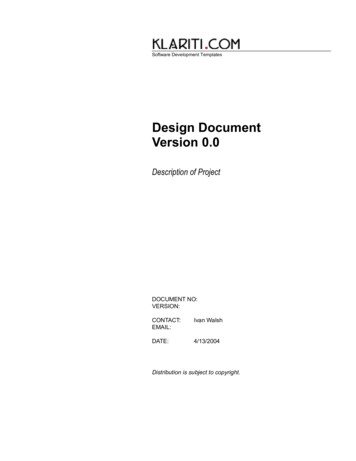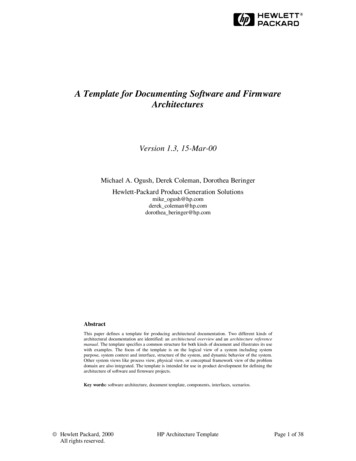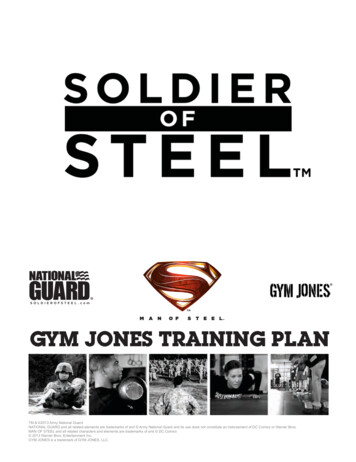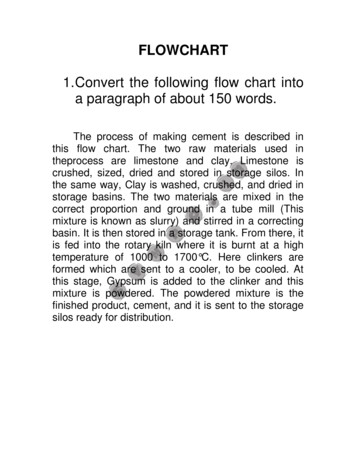
Transcription
FLOWCHART1. Convert the following flow chart intoa paragraph of about 150 words.The process of making cement is described inthis flow chart. The two raw materials used intheprocess are limestone and clay. Limestone iscrushed, sized, dried and stored in storage silos. Inthe same way, Clay is washed, crushed, and dried instorage basins. The two materials are mixed in thecorrect proportion and ground in a tube mill (Thismixture is known as slurry) and stirred in a correctingbasin. It is then stored in a storage tank. From there, itis fed into the rotary kiln where it is burnt at a hightemperature of 1000 to 1700 C. Here clinkers areformed which are sent to a cooler, to be cooled. Atthis stage, Gypsum is added to the clinker and thismixture is powdered. The powdered mixture is thefinished product, cement, and it is sent to the storagesilos ready for distribution.
Raw edDriedStored is sibsStored in storage binsMixed in correct proportionsGroung in a tube mill(slurry)Stirred in a correcting basinStorage tankRotary Kiln lobe burnt at 1000C to1700 CClinkers are formedGypsum is addedCooled in a coolerMixed and powderedThe powder is stored in storagesibsCement is ready for distribution
2. Convert the following passage into a flow chart.The earth contains a large number of metalswhich are useful to man. One of the most important ofthese is Iron. The Iron ore which we find on the earthis not pure. It contains some impurities which wemust remove by smelting. The process of smeltingconsists of heating the ore in a blast furnace withcoke and limestone and reducing it to metal. Blasts ofhot air enter the furnace from the bottom and providethe oxygen which is necessary for the reduction of theore. The ore becomes molten, and its oxides combinewith carbon from the coke. The nonmetallicconstituents of the ore combine with limestone to forma liquid slag. This floats on top of the molten iron andpasses out of the furnace through a tap. The metalwhich remains is pig iron. We can melt this again inanother furnace – a cupola – with more coke andlimestone and tap it out into a ladle or directly intomoulds. This is cast iron.
ImpureHeated in a blastfurnace with cokeHot air is blown fromthe bottom to provideoxygenOre becomesOxides combinewith carbon formPig ironMelted in anotherfurnace coupled withcoke and limestoneTrapped into moulds Non metallicconstituents combinewith limestone to
3. Given below is a process description. Read it anddraw a flow chart representing the processdescribed.Rayon is a man-made fibre. It is a reconstitutednatural fibre-cellulose. Rayon is made by dissolvingcellulose in a solution of sodium hydroxide, or causticsoda. The cellulose is obtained from shredded woodpulp. The dissolved cellulose is formed into threadsby forcing it through a spinneret in a setting bath ofdilute sulphuric acid. The threads are drawn from thesetting bath, wound on a reel, washed, then dried ona heated roller, and finally wound on to a bobbin.
Process of making RAYONShredded wood pulpCelluloseDissolved in Sodium HydroxideForced through a spinneret in dilute sulphuric acidThreads formedWound on a reelWashedDried on a heated rollerWound on a bobbin
4. Read the following passage carefully. Representthis by means of a flow chart.Silver occurs in the ores of several metals. The frothprocess of extracting silver, accounts forabout 75% of all silver recovered. Here the ore isground to a powder, then placed in large vatscontaining a water suspension of frothing agents, andthoroughly agitated by jets of air. Depending on theagents used, either the silver bearing ore or thegangue adhering to the bubbles of the froth, isskimmed off and washed. The final refining is doneusing electrolysis
Extraction of silverOre of silver metalGround to powderPlaced in a vat containing frothing agentsAgitated by airThe ore is skimmedWashedRefined by electrolysisSilver
5. Using the information provided in the given text,draw a flow chart describing the differentstages involved in the making of coins. Remember togive an appropriate title to your flow chart:Coins are manufactured in a factory known as‘mint’. There are three mints in India: Bombay,Calcutta and Hyderabad. Production of coins at themints is a complete process. It starts with the buyingof unmixed metals and their testing by the AssayDepartment. Then the metals are alloyed in oil-fired orelectric arc furnaces, and cast into ingots 40 cm wide,15 cm thick and 6 m long. These ingots are reheateduntil the temperature is hot enough for hot rolling.During this stage, the ingots pass through a series ofrollers until they form long, thin sheets which are ofthe thickness of a coin. From these thin strips, blankdiscs are punched. These are the basic raw materialsfor the manufacture of coins. The blanks are heatedto soften them, and they are rolled so that the rim israised. Finally they are stamped with the design of thecoin. At every stage, defective pieces are carefullysorted out, and (with the frequent checking andreturning points) strict quality control maintained.Rejects are returned to the alloying stage, togetherwith the waste from the alloy strip.
Umnixed Metals are takenTested by the assay DeptConverted into an alloy in afurnaceCast into ingots(of the requiredsize)Good ingots selected and reheatedDefective ingots are removedPassed through a series of rollersuntil they become thin strips(disc)The faultless blank discs arepunchedDefective Discs are removedThey are heated again to besoftenedThey are rolled again for the rimsto be removedFaultless coins are selected anddesign stampedClear coins selectedSelected coins are collectedDefective and smudged coinsremovedDefective coins returned to thealloying stage
The process of making cement is described in this flow chart. The two raw materials used in theprocess are limestone and clay. Limestone is crushed, sized, dried and stored in storage silos. In the same way, Clay is washed, crushed, and dried in storage basins. The two materials are mixed in the correct proportion and ground in a tube mill (This mixture is known as slurry) and stirred in a .
